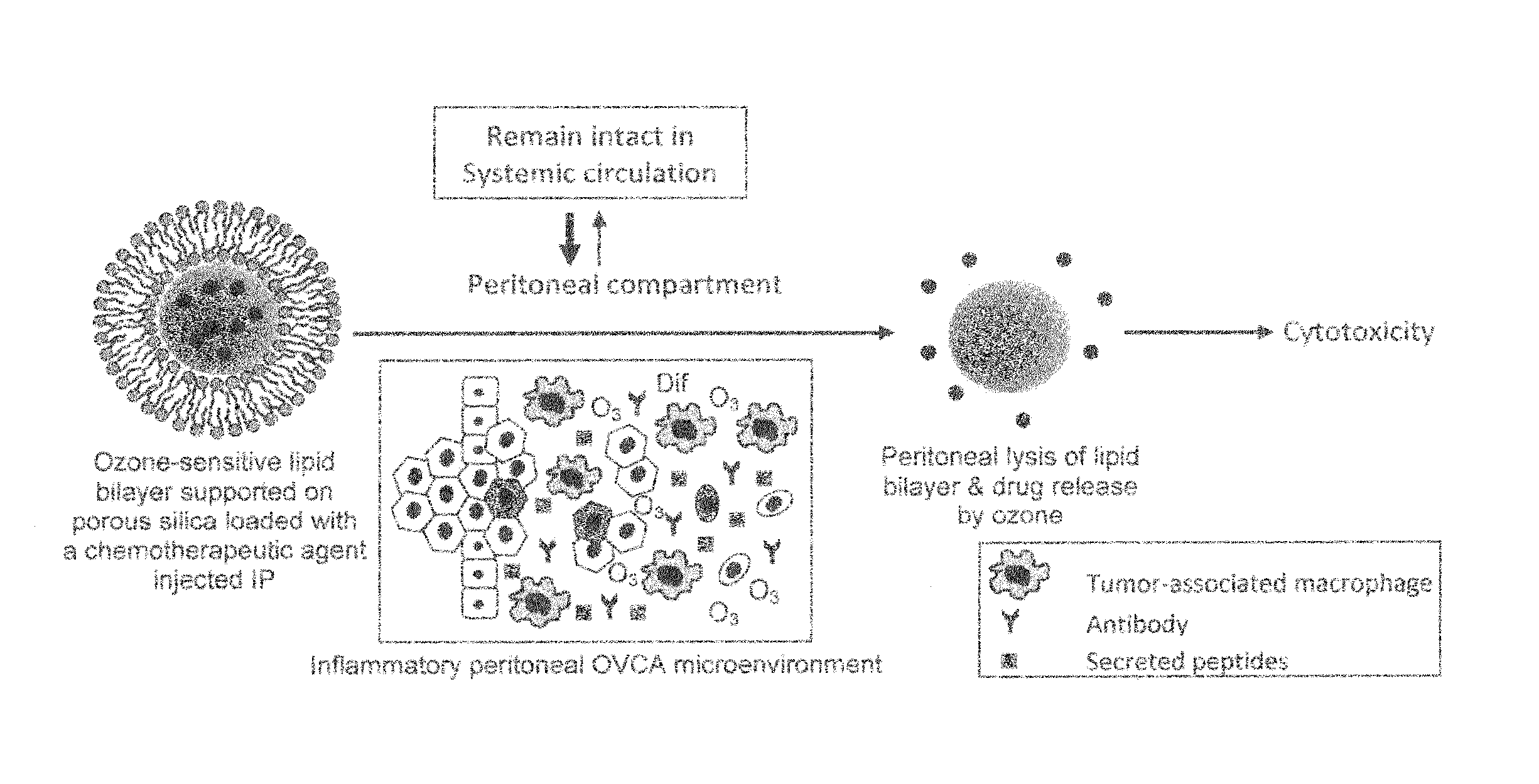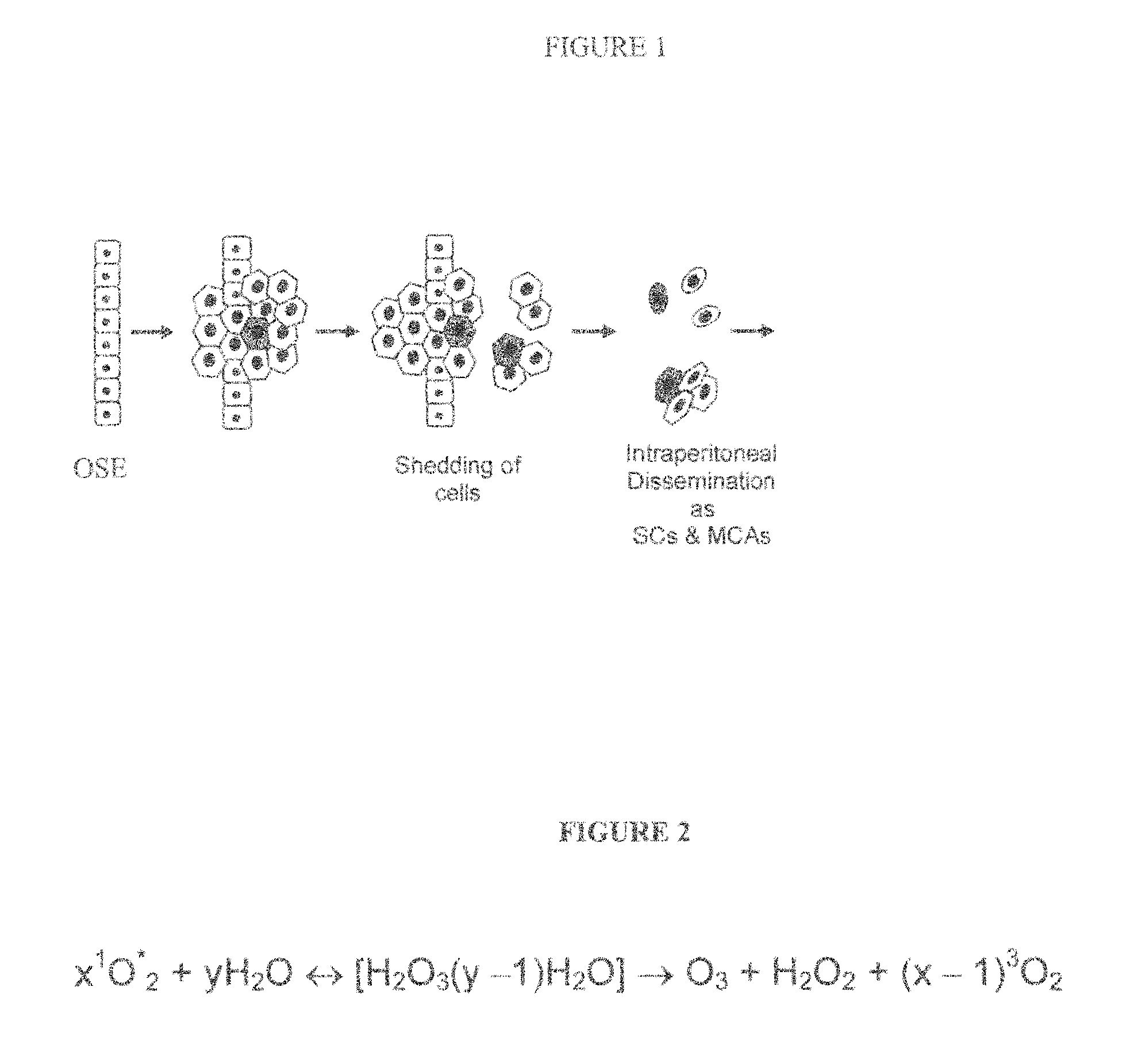Intraperitoneally-administered nanocarriers that release their therapeutic load based on the inflammatory environment of cancers
a nanocarrier and inflammatory environment technology, applied in the field of nanocarriers, can solve the problems of leakage of contents such as chemotherapeutic agents,
- Summary
- Abstract
- Description
- Claims
- Application Information
AI Technical Summary
Benefits of technology
Problems solved by technology
Method used
Image
Examples
example 1
Generation of Ozone and Disruption of SLB.
1. Overview.
[0111]Since OVCA is a peritoneal disease, then, logically, introducing therapeutic drugs intraperitoneally (IP) directly to the site of the disease must have higher efficacy than the intravenous (IV) route. In addition, pre-clinical studies demonstrate that the IP route allows for administering higher concentration of chemotherapeutic agents than the IV route [45]. In fact, the IP route of administering chemotherapy conferred greater overall survival rates alone or in combination with IV route [2-5]; however, the main problem associated with IP administration is higher rates of systemic toxicities [2, 35, 46]. We plan to design a nanocarrier that releases its therapeutic content only peritoneally and not in the circulation in order to overcome the current problems of systemic toxicity associated with IP therapy. Our nanocarrier will be made of an ROS-sensitive lipid bilayer that is supported on porous silica nanospheres (FIG. 3)....
example 2
Porous Silica Spheres.
[0117]The system described under FIG. 7 is exposed to ozone produced photochemically (i.e. by exposure to UVA and presence of 6BP) by tryptophan. Porous nanosilica spheres with size range 200-500 nm are synthesized according to published procedure [50]. Flow cytometry detects release of the fluorescein content of the nanocarrier (FIG. 8). To optimize the lipid make up of the SLB, various phosphatidyl-cholines (PCs) are evaluated in addition to cholesterol (all available from Avanti Polar Lipids, Alabaster, Ala.). PCs tested include egg PC as an example of a lipid mixture that has ˜54% of its content as unsaturated PC. Additional PCs evaluated have different chain lengths and varying saturations to optimize the lysis in response to ozone generation while maintaining stability on silica. Some PCs that are used are reported to undergo lysis by ozone generation when they are part of SLBs include 1,2-dimyristoyl-sn-glycero-3-phosphocholine (DMPC), 1,2-dioleoyl-3-tri...
example 3
Cytotoxicity of DOX in the Presence of ROS.
[0122]One of the observed improvements in OVCA therapy results from using nanocarriers leading to enhanced targeting of OVCA and the use of chemotherapeutic agents other than platinum- and taxane-based therapies (to which OVCA may become resistant). For example, use of doxorubicin-loaded liposomes that are functionalized by polyethylene glycol (PEG) for OVCA such as Caelyx® (Schering-Plough) and Doxil® (Centocor Ortho Biotech) [5, 52-54]. These nanocarriers demonstrated the efficacy of using doxorubicin (DOX) in OVCA, although DOX was not among the chemotherapeutic agents usually employed for OVCA therapy. Because of that we also plan to test DOX with our system in addition to the advantage of the fluorescent nature of DOX, which allows for easy detection intracellularly using fluorescence microscopy. Aim 2 tests the cytotoxicity of DOX released by the vehicle we are developing in this proposal in presence of ROS. For that reason, we will t...
PUM
| Property | Measurement | Unit |
|---|---|---|
| pore size | aaaaa | aaaaa |
| temperature | aaaaa | aaaaa |
| diameter | aaaaa | aaaaa |
Abstract
Description
Claims
Application Information
 Login to View More
Login to View More - R&D
- Intellectual Property
- Life Sciences
- Materials
- Tech Scout
- Unparalleled Data Quality
- Higher Quality Content
- 60% Fewer Hallucinations
Browse by: Latest US Patents, China's latest patents, Technical Efficacy Thesaurus, Application Domain, Technology Topic, Popular Technical Reports.
© 2025 PatSnap. All rights reserved.Legal|Privacy policy|Modern Slavery Act Transparency Statement|Sitemap|About US| Contact US: help@patsnap.com



